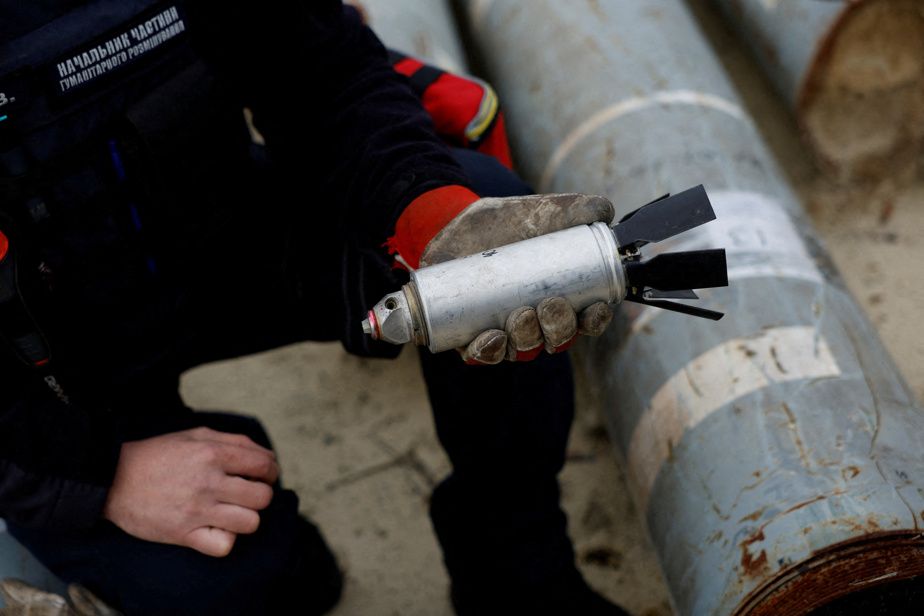What is a cluster munition?
It’s basically a container full of little bombs. The main device drops these submunitions, which scatter over a wide radius and explode – or should, since 5% to 40% of them would remain intact.
Why are these weapons controversial?
Unexploded submunitions can detonate long after the troops have left. Almost half of the victims of these bombs are children, and the vast majority are civilians, according to 2019 figures from the UN.
Since 2008, 123 countries have joined the Convention on Cluster Munitions and agreed never to produce, use, stockpile or transfer these bombs, in addition to committing to promote universal adherence to the treaty.
Neither the United States, nor Russia, nor Ukraine have ratified it, unlike Canada. “We do not support the use of cluster munitions and we are committed to ending the effects of these weapons on civilians, especially children,” commented Emily Williams, director of communications at the office of Foreign Affairs Minister Mélanie Joly reacting to the news.
Earl Turcotte led the Canadian delegation to the Convention. He challenged the Canadian government this week to urge it to put pressure on the United States against sending cluster bombs. “These are weapons that do not discern in their target. They are designed like that, to cover a large territory”, denounces the former diplomat, in a telephone interview with The Press.
He worked on the issue of cluster munitions for the UN in Laos. “During the Vietnam War, the United States heavily bombed the region, and half a century later, a third of the country is still uncontaminated with unexploded ordnance, mostly submunitions”, illustrates he.
It’s simple technology, but very, very deadly and long-lasting.
Earl Turcotte, Canada’s former chief negotiator for the Convention on Cluster Munitions
Why are they used?
“These are ammunition to do damage on a larger territory, explains Walter Dorn, professor at the Royal Military College of Canada. If you send a single grenade or a single bomb into a territory, it will affect a circle around that region, whereas with multiple submunitions you can cover a much larger territory. »
He thinks it can “give Ukraine a big advantage, especially offensively, when they need to attack Russia’s defensive positions”.
How could they be used in Ukraine?
Brian Lee Cox, attached to Cornell University and visiting professor at the University of Ottawa, has been following the question closely since the first rumors of an American shipment of this type of weapon. “When I saw that requests for submunitions were starting to be better received, I thought it was probably because the Ukrainian army is having trouble getting through Russian trenches and defensive positions, he advances. Cluster bombs would be ideal against troops in the trenches, but also against command posts. »
The former American soldier says he understands the fears raised by opponents of the use of this type of weapon, but sees strategic advantages in it.
Are they already used in the war in Ukraine?
Yes, mainly by Russia, but the Ukrainians have also used them, according to observations by Human Rights Watch, which deplores the American decision. “We have documented the extensive use of cluster bombs by Russian forces, from the first hours of the invasion, and we have seen the horrific consequences of these weapons on civilians,” comments Richard Weir, crisis researcher and conflicts for the organism. We expect to see the same consequences no matter who uses these weapons, Ukraine, Russia or the United States. This is why we oppose their use. »
He raises doubts about the assertions of the Pentagon, which ensures that the failure rate of cluster munitions sent to Ukraine would be less than 3%. “There is not a lot of transparency in what is sent to Ukraine, what happens, he raises. These weapons make victims indiscriminately. »
Why hadn’t the United States sent cluster munitions yet?
In an interview with CNN, US President Joe Biden justified the decision by saying that the Ukrainians are “out of ammunition” and that it was a “very difficult” decision for him.
“There seems to have been fear of diplomatic repercussions, because the United States and its allies, particularly those in NATO, are trying to keep a unity in the coalition of countries that support Ukraine,” notes Mr. Cox.
The majority of NATO member countries have signed the Convention on Cluster Munitions, which puts the United States in a delicate position.
“I think their approach has changed because of Ukraine’s difficulties in a counter-offensive,” adds Cox.
Mr. Dorn also believes that the situation on the ground had an influence. “Ukraine wants to launch a major offensive, the timing is really important,” he said. The United States was not ready to supply them with these weapons, but ended up agreeing. »
Mr. Turcotte, for his part, sees no valid reason for the use of cluster munitions. “There are many other options, it is not a necessity”, he pleads, citing as proof the 123 countries committed not to use them.
With Melanie Marquis, The Pressand Agence France-Presse
